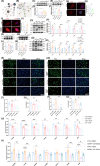IGFBP7 promotes endothelial cell repair in the recovery phase of acute lung injury
- PMID: 38840498
- PMCID: PMC11196208
- DOI: 10.1042/CS20240179
IGFBP7 promotes endothelial cell repair in the recovery phase of acute lung injury
Abstract
IGFBP7 has been found to play an important role in inflammatory diseases, such as acute lung injury (ALI). However, the role of IGFBP7 in different stages of inflammation remains unclear. Transcriptome sequencing was used to identify the regulatory genes of IGFBP7, and endothelial IGFBP7 expression was knocked down using Aplnr-Dre mice to evaluate the endothelial proliferation capacity. The expression of proliferation-related genes was detected by Western blotting and RT-PCR assays. In the present study, we found that knockdown of IGFBP7 in endothelial cells significantly decreases the expression of endothelial cell proliferation-related genes and cell number in the recovery phase but not in the acute phase of ALI. Mechanistically, using bulk-RNA sequencing and CO-IP, we found that IGFBP7 promotes phosphorylation of FOS and subsequently up-regulates YAP1 molecules, thereby promoting endothelial cell proliferation. This study indicated that IGFBP7 has diverse roles in different stages of ALI, which extends the understanding of IGFBP7 in different stages of ALI and suggests that IGFBP7 as a potential therapeutic target in ALI needs to take into account the period specificity of ALI.
Keywords: ALI; c-fos; cell proliferation; igfbp7; yap.
© 2024 The Author(s).
Conflict of interest statement
The authors declare that there are no competing interests associated with the manuscript.
Figures








Similar articles
-
Activated Clec4nhi Neutrophils Aggravate Lung Injury in an Endothelial IGFBP7-Dependent Manner.Am J Respir Cell Mol Biol. 2024 Jul;71(1):66-80. doi: 10.1165/rcmb.2024-0017OC. Am J Respir Cell Mol Biol. 2024. PMID: 38574235
-
IGFBP7 aggravates sepsis-induced acute lung injury by activating the ERK1/2 pathway.Folia Histochem Cytobiol. 2020;58(4):247-254. doi: 10.5603/FHC.a2020.0028. Epub 2020 Dec 16. Folia Histochem Cytobiol. 2020. PMID: 33326113
-
Lipopolysaccharide-Induced Acute Lung Injury Is Associated with Increased Ran-Binding Protein in Microtubule-Organizing Center (RanBPM) Molecule Expression and Mitochondria-Mediated Apoptosis Signaling Pathway in a Mouse Model.Med Sci Monit. 2020 Jul 18;26:e923172. doi: 10.12659/MSM.923172. Med Sci Monit. 2020. PMID: 32680981 Free PMC article.
-
Insulin-like growth factor-binding protein 7 (IGFBP7): A microenvironment-dependent regulator of angiogenesis and vascular remodeling.Front Cell Dev Biol. 2024 Jul 9;12:1421438. doi: 10.3389/fcell.2024.1421438. eCollection 2024. Front Cell Dev Biol. 2024. PMID: 39045455 Free PMC article. Review.
-
The multifaceted role of insulin-like growth factor binding protein 7.Front Cell Dev Biol. 2024 Jul 16;12:1420862. doi: 10.3389/fcell.2024.1420862. eCollection 2024. Front Cell Dev Biol. 2024. PMID: 39081862 Free PMC article. Review.
Cited by
-
scPRINT: pre-training on 50 million cells allows robust gene network predictions.Nat Commun. 2025 Apr 16;16(1):3607. doi: 10.1038/s41467-025-58699-1. Nat Commun. 2025. PMID: 40240364 Free PMC article.
-
IGFBP7 inhibition relieves LPS induced nucleus pulposus cell injury by regulating the ERK1/2 pathway.Cytotechnology. 2025 Jun;77(3):116. doi: 10.1007/s10616-025-00784-w. Epub 2025 Jun 6. Cytotechnology. 2025. PMID: 40488211
References
-
- Usui T., Murai T., Tanaka T., Yamaguchi K., Nagakubo D., Lee C.M.et al. . (2002) Characterization of mac25/angiomodulin expression by high endothelial venule cells in lymphoid tissues and its identification as an inducible marker for activated endothelial cells. Int. Immunol. 14, 1273–1282 10.1093/intimm/dxf102 - DOI - PubMed
MeSH terms
Substances
Grants and funding
LinkOut - more resources
Full Text Sources
Molecular Biology Databases
Miscellaneous

